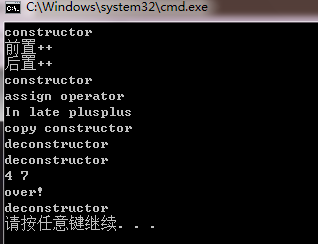测试环境:VS2008
1. 仅对内置数据类型自加,两者效率一样
#include <iostream>
using namespace std;
int main()
{
int a=1,b=2;
a++;
++b;
return 0;
}汇编代码如下:
int a=1,b=2;
00F4138E mov dword ptr [a],1
00F41395 mov dword ptr [b],2
a++;
00F4139C mov eax,dword ptr [a]
00F4139F add eax,1
00F413A2 mov dword ptr [a],eax
++b;
00F413A5 mov eax,dword ptr [b]
00F413A8 add eax,1
00F413AB mov dword ptr [b],eax
return 0;可以看出,前置++的a和后置++的b的操作是一样的·,两者效率一样
可见,前置++和后置++都有三个步骤:
- 从内存中,拷贝数据到寄存器
- 寄存器值加1
- 从寄存器中,拷贝数据到内存
2. 非内置数据类型,前置++比后置++效率高
#include <iostream>
using namespace std;
class Point //定义一个点类
{
public:
int x,y;
public:
Point& operator=(Point& hpoint) //赋值运算符
{
x = hpoint.x;
y = hpoint.y;
cout<<"assign operator"<<endl;
return *this;
}
Point(int _x,int _y):x(_x),y(_y) //构造函数
{
cout<<"constructor"<<endl;
}
Point() //默认构造函数
{
x = 0;
y = 0;
cout<<"constructor"<<endl;
}
Point(Point& ptem) //拷贝构造函数
{
x = ptem.x;
y = ptem.y;
cout<<"copy constructor"<<endl;
}
~Point()
{
cout<<"deconstructor"<<endl;
}
//参数int没有实际的意义,仅表示后置加加,返回对象
Point operator++(int);
//前置加加,返回对象的引用
Point& operator++();
};
Point& Point::operator++() //前置
{
x++;
y++;
return *this;
}
Point Point::operator++(int) //后置
{
Point tem; //局部变量
tem = *this;
cout<<"In late plusplus"<<endl;
++(*this);
return tem;
}
int main()
{
Point pt(2,5);
cout<<"前置++"<<endl;
++pt;
cout<<"后置++"<<endl;
pt++;
cout<<pt.x<<" "<<pt.y<<endl;
cout<<"over!"<<endl;
return 0;
}汇编代码如下:
++pt;
0022199B lea ecx,[ebp-18h]
0022199E call Point::operator++ (22100Fh)
pt++;
002219CE push 0
002219D0 lea eax,[ebp-0F4h]
002219D6 push eax
002219D7 lea ecx,[ebp-18h]
002219DA call Point::operator++ (22124Eh)
002219DF lea ecx,[ebp-0F4h]
002219E5 call Point::~Point (22103Ch) 运行结果如下:
由上可知:
(a)前置++返回的是自身的引用(返回引用可以用于链式运算)
(b)后置++,多生成了两个类对象,一个是局部对象tem和返回的临时对象。
所以,对于自定义类型,前置++较后置++效率高。
